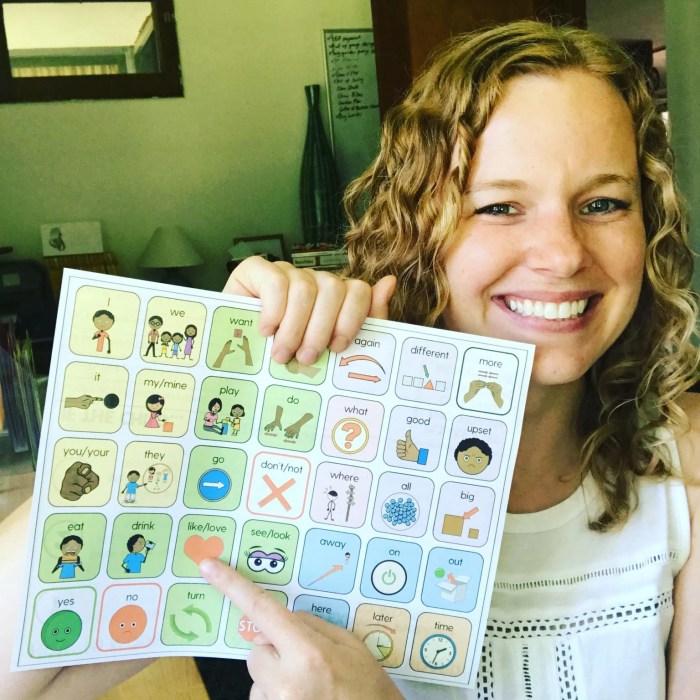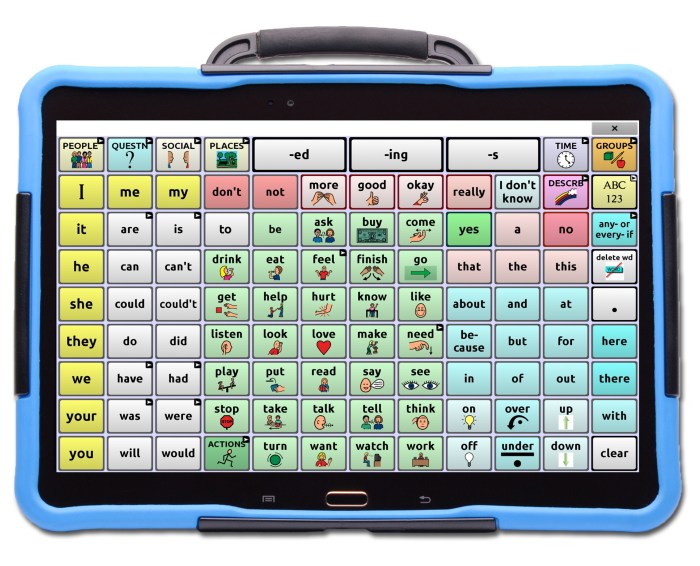AAC goals for emergent communicators are essential for fostering communication development in individuals with complex communication needs. These goals aim to empower individuals by providing them with alternative and augmentative communication (AAC) strategies to express their thoughts, needs, and desires.
Establishing clear AAC goals is crucial for effective intervention. These goals should focus on key areas such as communication initiation, requesting and responding, and social interaction.
Understanding Emergent Communicators

Emergent communicators are individuals who are in the early stages of language development. They may have limited or no verbal speech and rely on other means of communication, such as gestures, facial expressions, and vocalizations. Emergent communicators face unique challenges in communication due to their limited language skills and may require support from augmentative and alternative communication (AAC) devices to express themselves effectively.
Characteristics of Emergent Communicators
- Limited or no verbal speech
- Reliance on gestures, facial expressions, and vocalizations
- Difficulty understanding and expressing language
- May have cognitive or physical disabilities that affect communication
Importance of AAC for Emergent Communicators
AAC is essential for emergent communicators as it provides them with a way to express their thoughts and needs. AAC devices can range from simple picture boards to complex electronic communication systems. By using AAC, emergent communicators can improve their communication skills, participate more fully in social interactions, and gain a greater sense of independence.
Establishing AAC Goals

Establishing appropriate AAC goals is crucial for the successful implementation of AAC systems for emergent communicators. These goals should be individualized, functional, and based on the individual’s communication needs and abilities.
Principles of Setting AAC Goals
The principles of setting AAC goals for emergent communicators include:
- Individualization:Goals should be tailored to the specific needs and abilities of each individual.
- Functionality:Goals should focus on improving the individual’s ability to communicate effectively in everyday situations.
- Progression:Goals should be set in a logical progression, starting with basic communication skills and gradually increasing in complexity.
- Collaboration:Goals should be developed in collaboration with the individual, their family, and other professionals involved in their care.
Key Areas to Focus On, Aac goals for emergent communicators
Key areas to focus on when setting AAC goals for emergent communicators include:
- Communication initiation:Teaching the individual how to initiate communication with others.
- Requesting and responding:Teaching the individual how to make requests and respond to others.
- Social interaction:Teaching the individual how to use AAC to engage in social interactions.
Methods for AAC Intervention

Various methods can be employed for AAC intervention with emergent communicators, each tailored to their unique needs and communication styles. These methods include direct teaching, incidental teaching, and supported communication.
Direct Teaching
Direct teaching involves structured and explicit instruction focused on teaching specific communication skills. It typically occurs in a one-on-one setting and may involve using flashcards, picture boards, or speech-generating devices.
- Example:A therapist teaches an emergent communicator how to use a picture board by associating specific pictures with corresponding words or phrases.
Incidental Teaching
Incidental teaching capitalizes on everyday situations and natural interactions to teach communication skills. It occurs spontaneously and is not formally structured.
- Example:During a meal, a caregiver points to a plate of food and says, “apple,” encouraging the emergent communicator to associate the word with the object.
Supported Communication
Supported communication involves providing physical or cognitive assistance to emergent communicators to facilitate their communication. This can include using sign language, gestures, or adaptive technology.
- Example:A caregiver assists an emergent communicator with cerebral palsy by supporting their arm to help them make gestures or use a communication device.
Assessing Progress and Making Adjustments

Ongoing assessment is crucial in AAC intervention as it allows clinicians and educators to monitor a communicator’s progress, evaluate the effectiveness of the intervention plan, and make necessary adjustments to ensure optimal outcomes.
Methods for tracking progress and evaluating outcomes include:
- Formal assessments:Standardized tests and assessments can provide objective data on a communicator’s progress in specific areas, such as language comprehension, expressive language, and social communication.
- Informal assessments:Observations, anecdotal notes, and progress monitoring tools can provide valuable insights into a communicator’s progress in real-world settings.
- Self-assessment:Involving communicators in the assessment process can provide valuable feedback on their progress and areas where they feel they need additional support.
Making Adjustments to AAC Goals and Intervention Plans
Based on assessment results, clinicians and educators may need to make adjustments to AAC goals and intervention plans. This may involve:
- Revising goals:If a communicator is not making progress towards a specific goal, the goal may need to be revised or broken down into smaller, more achievable steps.
- Adjusting intervention strategies:The intervention plan may need to be adjusted to include different activities, materials, or approaches that are more effective for the communicator.
- Changing the AAC system:In some cases, the AAC system may need to be changed to better meet the communicator’s needs.
Collaboration and Support: Aac Goals For Emergent Communicators

Effective AAC intervention for emergent communicators requires a collaborative approach that involves the child, their family, and a team of professionals. Collaboration fosters a shared understanding of the child’s communication needs and ensures that interventions are tailored to their unique strengths and challenges.
Supporting Families and Caregivers
Families and caregivers play a crucial role in supporting the AAC journey of emergent communicators. They provide a consistent and nurturing environment where the child can practice and develop their communication skills. Professionals can support families by:
- Providing education and training on AAC strategies
- Offering emotional support and guidance
li>Connecting families with resources and support groups
Resources and Organizations
Various resources and organizations offer support and information on AAC for emergent communicators and their families. These include:
- American Speech-Language-Hearing Association (ASHA)
- International Society for Augmentative and Alternative Communication (ISAAC)
- The National Association for Down Syndrome (NDS)
FAQ Insights
What are the benefits of AAC for emergent communicators?
AAC can improve communication skills, increase social interaction, reduce frustration, and enhance overall quality of life.
How do I choose the right AAC system for my child?
Consider your child’s individual needs, communication abilities, and preferences. Consult with a speech-language pathologist for guidance.
How can I support my child’s AAC development at home?
Provide opportunities for communication, model AAC use, and create a supportive environment where your child feels comfortable expressing themselves.